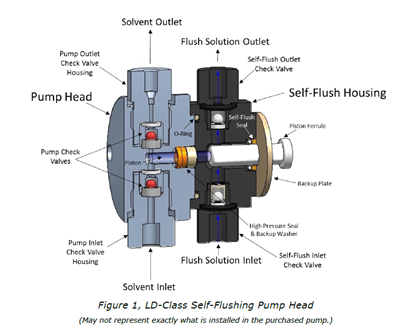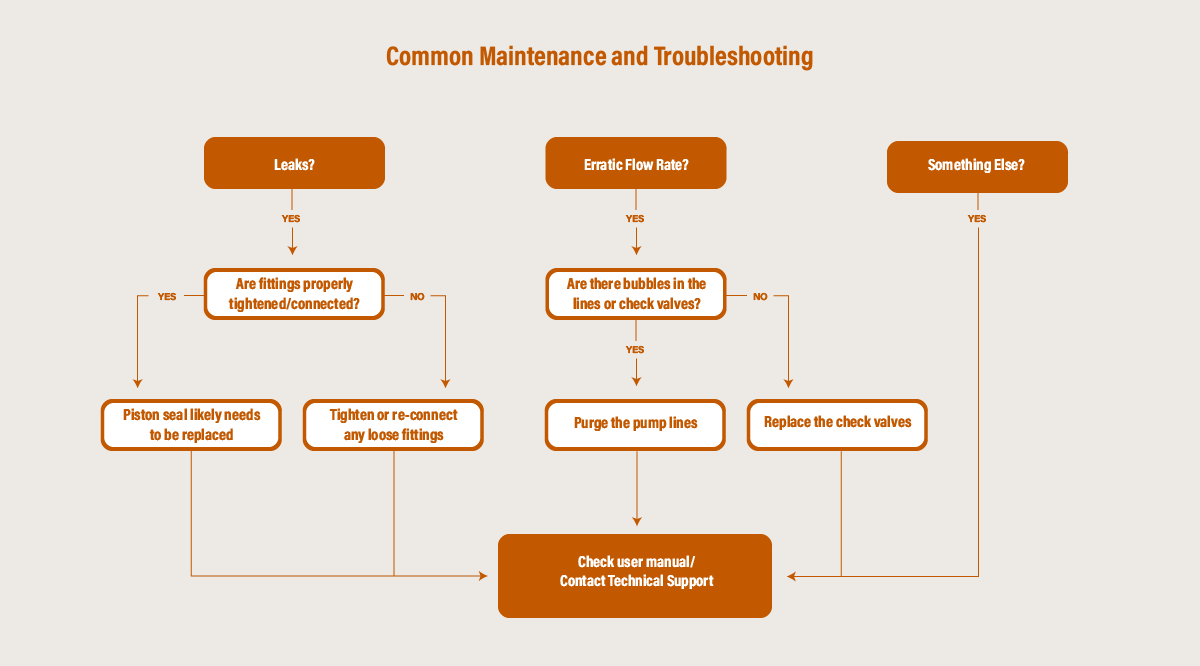26th Jun 2025
HPLC Pump Care and Troubleshooting

Many of the technical support inquiries we receive at Chrom Tech are related to care and troubleshooting of our continuous process pumps. Some of the topics include:
- My pump has erratic flow rates
- My pump has no flow out the outlet check valve
- I'm noticing pressure fluctuation
- Fluid is leaking in my pump
All of these issues could mean:
- Bubble in the pump's check valve, dirty check valve, or bad check valve
- Leaks due to worn piston seals or scratched piston
- HPLC fittings not tightened correctly
Possible causes could be the solvent was not properly degassed, the mobile phase was not properly filtered, the inlet solvent filter is plugged, fittings were not plumbed correctly, or particulates from worn piston seals were caught in the check valve.
Bubbles in my System; how do you get air out of an HPLC pump?
Proper solvent preparation will prevent a great number of pumping problems. The most common problem is bubble formation, which may affect the flow rate consistency. Aside from leaky fittings, the problem of bubble formation arises from two sources: solvent out-gassing and cavitation. Filtration of HPLC solvents is also required.
Solvent Out-Gassing and Sparging
Solvent out-gassing occurs because the mobile phase contains dissolved atmospheric gases, primarily N2 and O2. These dissolved gases may lead to bubble formation and should be removed by degassing the mobile phase before or during use. The best practical technique for degassing is to sparge the solvent with standard laboratory-grade (99.9+%) helium. Helium is only sparingly soluble in HPLC solvents, so other gases dissolved in the solvent diffuse into the helium bubbles and are swept from the system. Solvent filtration is not an effective alternative to helium degassing.
It is recommended to sparge the solvent vigorously for 10 to 15 minutes before using it. Then, maintain a trickle sparge during use to keep atmospheric gases from dissolving back into the mobile phase. The sparged solvent must be continually blanketed with helium at 2 to 3 psi. Non- blanketed, sparged solvents will allow atmospheric gases to dissolve back into the mobile phase within four hours.
Solvent mixtures using water and organic solvents (like methanol or acetonitrile) hold less dissolved gas than pure solvents. Sparging to reduce the amount of dissolved gas is, therefore, particularly important when utilizing solvent mixture.
Even with sparging, some out-gassing may occur. A back pressure regulator installed after the detector flow cell will help prevent bubbles from forming and, thus, limit baseline noise.
Cavitation
Cavitation occurs when inlet conditions restrict the flow of solvent and vapor bubbles are formed during the inlet stroke. The key to preventing cavitation is to reduce inlet restrictions. The most common causes of inlet restrictions are crimped inlet lines and plugged inlet filters. Inlet lines with tubing longer than 48" (120 cm) or with tubing of less than 0.085" (2 mm) ID may also cause cavitation.
Placing the solvent reservoirs below the pump level also promotes cavitation. The optimal location of the reservoirs is slightly above the pump level, but it is adequate to have them on the same level as the pump.
Viscosity of Solvent
When pumping a viscous solvent, increasing inlet head pressure will improve performance. We always recommend the inlet solvent reservoir bottle be placed above the pump to minimize the possibility of cavitation. For more viscous solvents, a helium sparge may also be required to further increase head pressure for optimal pump performance.
Filtration
Solvent filtration is good practice for the reliability of the HPLC pumps and other components in the system. Solvents should always be filtered with a 0.5-micron filter prior to use. This ensures that no particles will interfere with the piston seals and check valves. Solvents in which buffers or other salts readily precipitate out must be filtered more often. After filtration, the solvents should be stored in a closed, particulate-free bottle.
Solvents With Harmful Effects To Most HPLC Pumps
Except for PEEK pump heads, all portions of the Chrom Tech pumps that contact mobile phase are manufactured of type 316 stainless steel, ceramic, sapphire, ruby, or fluoropolymers. Some of these materials are extremely sensitive to acids (including some Lewis acids) and acid halides. Avoid using solvents that contain any amount of hydrochloric acid.
In addition, some users of these pumps have observed that chloroform and carbon tetrachloride slowly decompose to liberate hydrochloric acid, which, as noted above, attacks stainless steel. Do not leave these solvents in the systems for a prolonged period.
It is also recommended to avoid ammonium hydroxide. Although ammonium hydroxide will not harm the pump itself, it is likely to damage the stator and rotor in injection valves.
Use Gravity for Mobile Phase Reservoirs in the HPLC System
The mobile phase reservoir should be placed at the same level or slightly higher than the pump (never below the pump), and the inlet tubing should be as short as practical. These steps minimize pressure losses on the inlet side of the pump during refill and help to avoid bubble formation. These steps are particularly important when using high vapor pressure solvents (hexane, methylene chloride, etc.). Mobile phases should be degassed, filtered, and covered.
Use the Self-Flush Mechanism Whenever Possible To Extend Pisont Seal Life.
Self-flushing pump heads provide continuous washing of the piston surface without the inconvenience of a manual flush or gravity-feed arrangement. The self-flushing pump head uses a self-flush seal and secondary set of check valves to create a continuous and positive flow in the area behind the high-pressure pump seal. The flushing solution washes away any buffer salts that have precipitated onto the piston. If not removed, these precipitates can abrade the high-pressure seal and cause premature seal failure and leakage, and they can possibly damage the pump.

Recommended Use of Self-Flush Feature
It is strongly recommended that the Self-Flush feature be used to improve seal life in a number of applications. In particular, (as stated above) if pumping buffers, acids/bases, or any inorganic solution is near saturation, the pump must utilize the Self Flush feature. With every piston stroke, an extremely thin film of solution is pulled back past the seal. If this zone is dry (without the use of Self Flush) then crystals will form during continuous operation, which will ultimately damage the seal.
Another application where Self Flush is highly recommended is when pumping Tetrahydrofuran (a.k.a. THF, Diethylene Oxide) or other volatile solvents, such as acetone (Note: THF and most solvents are compatible only with all stainless-steel systems. THF will attack PEEK). Volatile solvents will dry rapidly behind the seal (without the use of Self Flush), which will dry and degrade the seal.
Solutions of either 100% IPA, 100% Methanol, 20% IPA/water mix, or 20% Methanol/water mix are the required choices for the flush solution. Do not use only water for the self-flush solution (e.g., DI water, tap water, filtered water), as water alone can cause abrasion of the high-pressure piston seal, as well as the self-flush seal. If there is any doubt about which self-flush solution to use, please consult Chrom Tech.

Replacing the Inlet Filter
Inlet filters should be checked periodically to ensure that they are clean and not restricting flow. A restriction could cause cavitation and flow loss in the pump. Two problems that can plug an inlet filter are microbial growth and impure solvents. To prevent microbial growth, use at least 10-20% organic solvent in the mobile phase or add a growth-inhibiting compound. If 100% water or an aqueous solution is pumped without any inhibitors, microbes will grow in the inlet filter over time, even if fresh solution is made every day. Always use well-filtered, HPLC-grade solvents for the mobile phase.
Replacing the Pump Piston Seals
Lower than normal pressure, pressure variations, and leaks in the pumping system can all indicate possible problems with the piston seal. Depending on the fluid or mobile phase used, piston seal replacement is often necessary after 1,000 hours of running time.
Cleaning the Piston
Gently squeeze the piston within a folded section with an appropriate scouring pad and rub the pad along the length of the piston. Rotate the pad frequently to assure the entire surface is scrubbed. Do not exert pressure perpendicular to the length of the piston, as this may cause the piston to break. After scouring, use a lint-free cloth, dampened with alcohol, to wipe the piston clean.
Check Valve Cleaning
Many check valve problems are the result of small particles interfering with the operation of the check valve.
1. To clean pump check valves, remove the pump head and immerse the entire head into a laboratory ultrasonic cleaner.
2. Sonicate for about 30 minutes using a standard cleaning solution. Rinse the pump head thoroughly with distilled water.
3. Replace the pump head assembly.
4. Run the pump at 1 mL/min (for an analytical pump) with distilled water for fifteen minutes. Always direct the output to a waste beaker during cleaning (do not recycle).
If this procedure does not return the pump to proper performance, the check valves should be replaced.
Cleaning or Flushing the Continuous Process Pump
1. Prepare the following solvents by utilizing the solvent preparation methods detailed in the above section:
a. 100% isopropanol
b. 100% filtered, distilled water
c. 20% nitric acid/water solution (only prepare if the flow path is stainless steel)
2. Direct the pump outlet line to a waste beaker.
3. Press the PRIME (P) button to set the pump flow rate to maximum OR set the pump flow rate to maximum flow rate.
4. Pump 100% isopropanol through the pump for 3 minutes.
5. Pump 100% filtered, distilled water through the pump for 3 minutes.
For stainless steel flow paths, proceed to Step 6; For PEEK flow paths, the cleaning procedure is completed.
6. Pump a 20% nitric acid/water solution through the pump for 3 minutes.
7. Flush the pump with 100% filtered, distilled water for at least 3 minutes.
8. Pump 100% isopropanol through the pump for 3 minutes.
The pump is now prepared for any mobile phase or short- or long-term shutdown.
Conclusion
Many high pressure dosing application pump issues relate back to the pump check Valves, piston seals, and fitting connections. We recommend properly degassing your high-purity solvent for trouble-free HPLC pump performance. In addition, routine preventative maintenance is recommended, which includes changing the inlet solvent filters, check valves, and piston seals.
Chrom Tech distributes HPLC accessories, including HPLC Instrument Replacement Parts, Idex Fittings, PEEK Tubing, and 316 Stainless Steel Tubing. As an authorized Agilent distributor, we feature Agilent Instrument Replacement Parts for HPLC and GC. Do you have an old Alltech pump but can’t find instrument replacement parts? If so, contact Chrom Tech today, as we have check valves, pistons, and seals for Alltech pumps.

